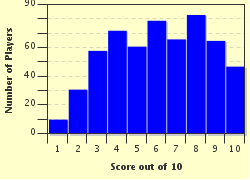Quiz Answer Key and Fun Facts
1. Which pair of compounds can be classified as inorganic?
2. Which are the four most abundant elements in living cells?
3. Which is an organic compound found in most cells?
4. Which formula represents an organic compound?
5. Which structure is usually present only in animal cells?
6. Which structure includes all of the others?
7. What is one function of the human endoskeleton?
8. What does the presence of cilia, an oral groove, and food vacuoles, and the absence of chloroplasts in a unicellular organism indicate that the organism carries on?
9. According to the heterotroph hypothesis, autotrophs were able to evolve because heterotrophs made conditions more favorable by doing what?
10. How does an organelle differ from an organ?
Source: Author
rcorr23
This quiz was reviewed by FunTrivia editor
crisw before going online.
Any errors found in FunTrivia content are routinely corrected through our feedback system.

